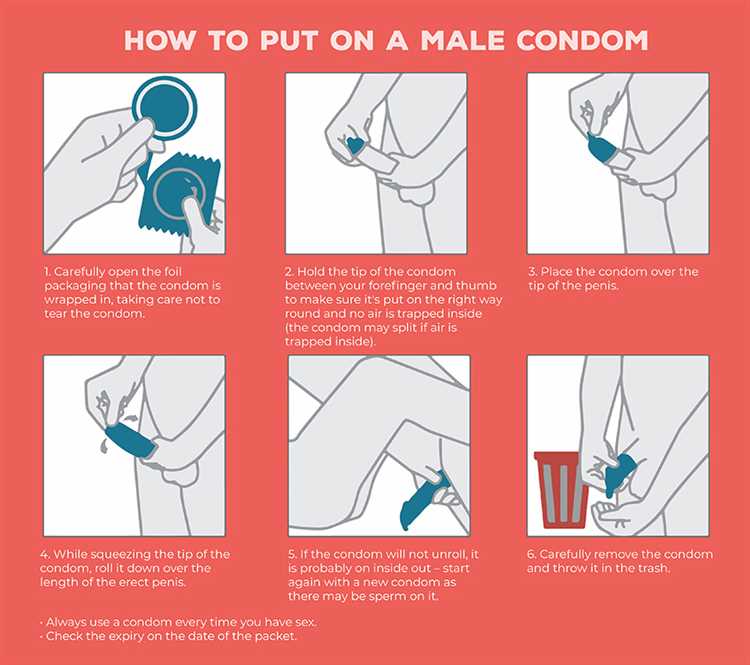
Condom use is an essential aspect of sexual health and preventing the spread of sexually transmitted infections (STIs) and unintended pregnancies. While condoms are widely available and promoted as an effective means of protection, the question remains: are they commonly used by most men?
Studies have shown that condom use can vary depending on various factors such as age, education, cultural beliefs, and relationship status. However, overall, condom use has been increasing in recent years and has become more widely accepted as an essential part of safe sexual practices.
It is important to note that condom use should be encouraged regardless of the above-mentioned factors. Condoms provide a barrier method of contraception that can greatly reduce the risk of STIs and unintended pregnancies. They are relatively inexpensive and readily available, making them accessible to men of all backgrounds and circumstances.
While the exact percentage of men who use condoms consistently is difficult to determine, it is evident that condoms are widely used and accepted as a means of protection. Public health campaigns, educational initiatives, and increased awareness about the importance of safe sex have all contributed to the promotion and use of condoms.
In conclusion, while individual condom use may vary, condoms remain an important tool in promoting sexual health and reducing the transmission of STIs and unintended pregnancies. Efforts should continue to be made to promote condom use and provide education about their effectiveness and accessibility to ensure that more men make use of this important form of protection.
- Usage of Condoms Among Men: Common or Not?
- The Prevalence of Condom Use
- Global Trends
- Factors Influencing Condom Use
- Targeted Interventions
- Factors Influencing Condom Usage
- Benefits of Condoms
- Cultural Attitudes Towards Condoms
- Challenges in Promoting Condom Use
- 1. Lack of Awareness and Education
- 2. Social and Cultural Factors
- 3. Cost and Accessibility
- 4. Perceived Reduction in Pleasure
- Q&A:
- Are condoms effective in preventing sexually transmitted infections?
- What percentage of men use condoms during sexual intercourse?
- What are the reasons why some men do not use condoms?
- Are there any alternatives to condoms for contraception?
- Do condoms only protect against unwanted pregnancies?
- Why is it important for men to use condoms?
Usage of Condoms Among Men: Common or Not?

When it comes to sexual health and contraception, condoms have proven to be an effective and reliable method for preventing unwanted pregnancies and sexually transmitted infections (STIs). However, the prevalence of condom use among men varies significantly across different demographics and cultural contexts.
In some societies, condom use is embraced widely and considered a responsible and essential part of sexual activity. These cultures prioritize safe sex practices and emphasize the importance of protecting oneself and one’s partner from potential risks. In such settings, condom usage is commonly promoted through sex education programs, government initiatives, and the availability of free or subsidized condoms.
On the other hand, there are regions where condom use is still relatively low and not widely accepted or practiced. This can be due to various factors, including cultural or religious beliefs, lack of access to condoms, stigma surrounding sex and contraception, or simply a lack of awareness about the benefits of condom use.
In many cases, men may feel embarrassed or uncomfortable discussing condom use or purchasing condoms, potentially contributing to a lower prevalence of condom usage. Additionally, there may be misconceptions or myths surrounding condoms that deter men from using them, such as the belief that condoms reduce sexual pleasure or that they are not necessary if one is in a committed relationship.
However, it is important to note that the use of condoms should not be solely the responsibility of men. Condom usage is a shared responsibility between sexual partners, and open communication about contraception and safe sex practices is crucial.
Overall, the usage of condoms among men can vary widely depending on factors such as cultural norms, education, accessibility, and individual attitudes. While condoms remain an important tool in preventing unwanted pregnancies and STIs, efforts should continue to promote condom use as a common and accepted practice to ensure the sexual health and well-being of both men and their partners.
The Prevalence of Condom Use
Condoms are an essential tool in preventing sexually transmitted infections (STIs) and unintended pregnancies. Understanding the prevalence of condom use among men is crucial in evaluating the effectiveness of public health campaigns and education programs.
Global Trends
In many countries, condom use has become increasingly common. The World Health Organization estimates that around 15 billion condoms are used worldwide every year. This indicates that condoms are being widely adopted as a means of protection.
However, the prevalence of condom use varies significantly between different regions and populations. For example, in some Western countries where comprehensive sex education is widely available, condom use rates tend to be higher compared to countries with limited access to such education.
Factors Influencing Condom Use
Several factors contribute to the prevalence of condom use among men. Education plays a crucial role, as individuals with a higher level of sexual education are more likely to use condoms consistently and correctly. Access to affordable condoms and the availability of condom promotion programs also play key roles in encouraging condom use.
Social and cultural factors can also influence condom use. Stigma and societal norms surrounding sexuality may discourage some men from using condoms, particularly in conservative or religious communities. Additionally, misconceptions and myths about condom use can lead to a decrease in usage rates.
Targeted Interventions
Efforts to promote condom use should take into account the specific needs and barriers faced by different populations. Targeted interventions, such as culturally sensitive educational campaigns and outreach programs, can help overcome barriers to condom use and increase its prevalence among specific populations.
It is also important to address the underlying factors that contribute to low condom use, such as lack of access to education, healthcare services, and economic barriers. By addressing these factors, we can work towards creating an environment where condom use is both accessible and widely practiced.
Factors Influencing Condom Usage
While condoms are widely available and promoted as an effective method for preventing sexually transmitted infections (STIs) and unintended pregnancies, there are several factors that can influence their usage among men. These factors include:
1. Knowledge and Awareness: Lack of knowledge or misconceptions about the importance and effectiveness of condom use can deter men from using condoms. Education and awareness campaigns are crucial in disseminating accurate information about safe sex practices.
2. Attitudes and Perceptions: Attitudes towards condoms can vary among different individuals and cultural groups. Negative perceptions about condoms, such as reduced pleasure or masculinity, can discourage men from using them. Positive attitudes and open discussions about condom usage can help challenge these preconceptions.
3. Peer Influence: Peer pressure and social norms can influence condom usage among men. If condom use is stigmatized or not socially accepted within a particular group, men may be less likely to use them. Encouraging a supportive and inclusive environment can help mitigate this barrier.
4. Accessibility and Affordability: Limited access to condoms, particularly in low-income communities or remote areas, can hinder their usage. Additionally, affordability may be an issue for some men who cannot afford to purchase condoms regularly. Increased availability and subsidized or free condom distribution can help address this challenge.
5. Relationship Dynamics: The nature of a sexual relationship can also influence condom usage. In committed or trusting relationships, where partners may assume monogamy or use other contraceptive methods, condom usage may be less likely. Effective communication and negotiation skills within relationships are vital for promoting condom use.
6. Substance Use: Substance use, such as alcohol or drugs, can impair decision-making and decrease inhibitions, leading to decreased condom usage. Encouraging responsible substance use and awareness of its impact on sexual behaviors can be key in promoting safer sex practices.
7. Motivation and Self-efficacy: Individual motivation and belief in one’s ability to consistently use condoms can greatly influence their usage. Building self-efficacy through comprehensive sex education programs and providing support and resources can empower men to prioritize and practice safe sex.
In conclusion, condom usage among men is influenced by various factors, including knowledge, attitudes, peer influence, accessibility, relationship dynamics, substance use, and individual motivation. Addressing these factors through comprehensive education, promoting positive attitudes, and ensuring accessibility can help increase condom usage and improve sexual health outcomes.
Benefits of Condoms

Condoms provide a variety of benefits that make them an essential tool for sexual health and prevention of sexually transmitted infections (STIs) and unintended pregnancies. Some of the main benefits of using condoms include:
| 1. STI Prevention | Condoms act as a barrier method to prevent the transmission of STIs during sexual activity. They can greatly reduce the risk of contracting infections such as HIV, gonorrhea, chlamydia, and syphilis. |
| 2. Pregnancy Prevention | Using condoms correctly and consistently can significantly reduce the risk of unintended pregnancies. They are an effective form of contraception as they prevent sperm from reaching the egg. |
| 3. Affordable and Accessible | Condoms are widely available and relatively inexpensive compared to other forms of contraception. They can be purchased at pharmacies, supermarkets, and even obtained for free at various sexual health clinics and organizations. |
| 4. Ease of Use | Condoms are easy to use and require minimal preparation. They can be quickly put on and taken off, making them a convenient option for both men and couples. |
| 5. Pleasurable and Comfortable | Modern condoms are made from high-quality materials that provide a comfortable and pleasurable experience during sexual intercourse. They are available in different sizes, shapes, and textures to enhance sexual pleasure. |
| 6. Dual Protection | Condoms offer dual protection against both STIs and unintended pregnancies. This makes them a reliable choice for individuals who want to safeguard their sexual health and avoid the risk of unplanned parenthood. |
It is important to note that using condoms correctly and consistently is key to maximizing their effectiveness. It is recommended to always read the instructions provided with the condom packaging and follow them carefully to ensure proper usage.
In conclusion, condoms provide numerous benefits that go beyond the prevention of STIs and unintended pregnancies. They are an accessible, affordable, and effective tool for promoting sexual health and well-being.
Cultural Attitudes Towards Condoms
The use of condoms varies greatly across different cultures and societies. Cultural attitudes towards condoms can significantly impact their acceptance and usage among men.
In some cultures, there may be a stigma associated with condoms, leading to hesitancy or reluctance to use them. This stigma could be due to cultural beliefs, religious teachings, or traditional values that view condom use as taboo or inappropriate.
On the other hand, there are cultures that promote and encourage condom use as a way to prevent sexually transmitted infections (STIs) and unintended pregnancies. These cultures may have comprehensive sex education programs that emphasize the importance of condom use in protecting sexual health.
The availability and accessibility of condoms can also influence cultural attitudes towards their use. In cultures where condoms are readily available and affordable, there may be higher acceptance and usage rates. Conversely, in cultures where condoms are scarce or expensive, their usage may be limited.
It is important to consider and respect cultural attitudes when promoting condom use. Effective strategies for increasing condom usage should address cultural beliefs and norms, provide accurate information, and promote positive attitudes towards condom use.
Changing cultural attitudes towards condoms requires a multi-faceted approach involving education, awareness campaigns, and community engagement. By addressing cultural barriers and promoting the benefits of condom use, societies can work towards creating a culture that embraces and prioritizes sexual health and well-being.
Challenges in Promoting Condom Use
While condoms are an effective method of contraception and protection against sexually transmitted infections (STIs), there are several challenges in promoting their use among men. Understanding and addressing these challenges is crucial for ensuring wider adoption of condoms and their positive impact on sexual health.
1. Lack of Awareness and Education
One of the primary challenges in promoting condom use is the lack of awareness among men regarding their benefits and importance. Many men may not be aware of the risks associated with unprotected sex or the effectiveness of condoms in preventing unwanted pregnancies and STIs. Lack of comprehensive sexual education programs and limited access to accurate information contribute to this challenge.
2. Social and Cultural Factors
Social and cultural factors also play a significant role in inhibiting condom use. In some societies, discussing sexual health openly is taboo, making it challenging to promote condom use as a preventive measure. Cultural norms and beliefs that prioritize male pleasure over sexual health may further discourage men from using condoms.
Additionally, traditional gender roles and the perception of masculinity often discourage men from taking responsibility for contraception. The stigma associated with condom use can also contribute to resistance among men.
3. Cost and Accessibility
The cost and accessibility of condoms can be a deterrent for some men. Lack of availability, especially in resource-constrained areas or low-income communities, can limit access to condoms. Financial constraints may make it difficult for men to purchase condoms regularly, leading to inconsistent use or non-use of condoms altogether.
4. Perceived Reduction in Pleasure
Another challenge in promoting condom use is the perception that using condoms reduces sexual pleasure. Some men may believe that condoms decrease sensitivity and intimacy during sexual activity, leading to a reluctance to use them. Addressing this concern through education and debunking myths about reduced pleasure can help overcome this challenge.
- Providing information about different types of condoms, including varieties designed to enhance pleasure, can also encourage their use.
- Promoting the message that condom use can enhance trust, communication, and mutual responsibility in sexual relationships can help counter the perceived reduction in pleasure.
In conclusion, promoting condom use among men requires addressing various challenges related to awareness, social and cultural factors, cost, and perceived reduction in pleasure. By implementing comprehensive sexual education programs, fostering an open dialogue about sexual health, improving accessibility to condoms, and debunking myths, it is possible to overcome these challenges and ensure wider adoption of condoms for improved sexual health outcomes.
Q&A:
Are condoms effective in preventing sexually transmitted infections?
Yes, condoms are highly effective in preventing sexually transmitted infections when used correctly and consistently. They serve as a barrier between partners, preventing the transmission of bodily fluids that can contain harmful infections.
What percentage of men use condoms during sexual intercourse?
The percentage of men who use condoms during sexual intercourse varies depending on various factors such as age, relationship status, and education. However, studies suggest that a significant portion of men (around 40-50%) use condoms regularly.
What are the reasons why some men do not use condoms?
There can be several reasons why some men do not use condoms. Some common reasons include a false sense of security, lack of education about their importance, discomfort or reduced sensitivity during sex, and opposition from their sexual partners. Additionally, cultural or religious beliefs may also play a role in the decision not to use condoms.
Are there any alternatives to condoms for contraception?
Yes, there are several alternative methods of contraception apart from condoms. These include hormonal methods such as birth control pills, patches, or injections, as well as intrauterine devices (IUDs), diaphragms, cervical caps, and fertility awareness methods. It is important to consult with a healthcare provider to determine the most suitable method for an individual’s needs.
Do condoms only protect against unwanted pregnancies?
No, condoms not only protect against unwanted pregnancies but also provide a significant barrier against sexually transmitted infections (STIs). They can greatly reduce the risk of contracting STIs such as HIV, gonorrhea, chlamydia, and syphilis, among others. It is important to use condoms consistently and correctly to ensure the maximum level of protection.
Why is it important for men to use condoms?
It is important for men to use condoms because it helps prevent unwanted pregnancies and reduces the risk of sexually transmitted infections (STIs) including HIV. Condoms are a simple and effective form of contraception and provide a barrier method of protection during sexual activity.